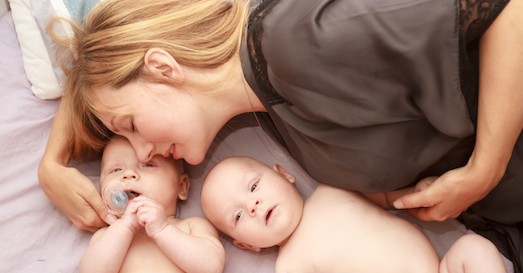Experiencing a triplet pregnancy brings immense joy and anticipation, but it also presents unique challenges, particularly when bed rest becomes necessary. Bed rest during a triplet pregnancy is often prescribed to manage complications or reduce risks associated with multiple births. This precautionary measure aims to safeguard both maternal and fetal health by minimizing stress on the mother’s body and promoting optimal conditions for the babies’ development.
Understanding why bed rest may be prescribed is crucial. It can help alleviate concerns and prepare expectant parents for the potential impact on their pregnancy journey. Managing bed rest effectively isn’t just about physical rest, it’s about maintaining emotional well-being, adhering to medical advice, and ensuring open communication with healthcare providers. This proactive approach plays a vital role in promoting a healthy pregnancy and increasing the chances of a positive outcome for both mother and babies.
Understand Bed Rest in Triplet Pregnancy
Bed rest is a medical intervention often prescribed during triplet pregnancies to manage specific conditions or reduce risks that could affect maternal and fetal health.
Reasons for Prescribing Bed Rest
Bed rest involves limiting physical activity and spending a significant amount of time lying down or reclining. It may be recommended for various reasons:
- Preventing Preterm Labor: Bed rest helps reduce the risk of premature birth by minimizing stress on the uterus and cervix.
- Managing High Blood Pressure: For mothers with hypertension or preeclampsia, bed rest can help regulate blood pressure and prevent complications.
- Reducing the Risk of Miscarriage: In cases where there are concerns about fetal viability or cervical insufficiency, bed rest may be prescribed to reduce the risk of miscarriage.
Medical Considerations Specific to Triplet Pregnancies
Triplet pregnancies are considered high-risk due to factors such as:
- Increased Risk of Preterm Birth: Multiple pregnancies often lead to premature labor, making it essential to manage activities to prolong gestation.
- Greater Physical Strain: Carrying three babies places significant strain on the mother’s body, requiring careful management of physical activity and rest.
- Higher Risk of Gestational Diabetes and Hypertension: Multiple pregnancies increase the likelihood of developing gestational diabetes or hypertension, necessitating monitoring and potential intervention.
Types of Bed Rest
Depending on the specific medical needs and condition of the mother, bed rest may be categorized into different types:
- Strict Bed Rest: Involves limited mobility with minimal allowance for sitting or standing. This type is typically prescribed for severe conditions requiring maximum fetal protection.
- Modified Bed Rest: Allows some flexibility in movement, such as limited walking or performing light household tasks. It aims to balance activity with the need for rest.
- Hospital Bed Rest: In cases where closer monitoring is necessary, bed rest may be recommended in a hospital setting with access to specialized care.
Understanding the nuances of bed rest in triplet pregnancies involves recognizing its purpose, tailored medical considerations, and the different types that may be prescribed based on maternal health and pregnancy progress. This knowledge empowers expectant parents to actively participate in their healthcare decisions and support optimal outcomes for both mother and babies.
Physical Health Maintenance
Maintaining physical health during bed rest in a triplet pregnancy is crucial for both maternal well-being and fetal development. Here are recommended exercises, activities, and tips to help manage physical health effectively.
Exercises and Activities Recommended During Bed Rest
During bed rest, it’s essential to engage in gentle exercises and activities that promote circulation, muscle tone, and overall physical well-being:
- Prenatal Yoga: Gentle yoga poses and stretches can help improve flexibility, reduce stress, and promote relaxation.
- Pelvic Floor Exercises: Kegel exercises strengthen pelvic muscles, which can aid in labor and postpartum recovery.
- Leg Exercises: Simple leg lifts or ankle rotations help prevent blood clots and maintain muscle strength in the legs.
Tips for Preventing Muscle Atrophy and Maintaining Mobility
Prolonged bed rest can lead to muscle weakness and loss of mobility. Follow these tips to minimize these risks:
- Range of Motion Exercises: Perform gentle stretches or range of motion exercises to keep joints flexible and prevent stiffness.
- Change Positions Regularly: Shift positions in bed every few hours to prevent pressure sores and maintain circulation.
- Use Supportive Pillows: Use pillows to support different parts of the body, such as under the legs or between the knees, to alleviate pressure and maintain comfort.
Nutrition Tips
Proper nutrition is essential during bed rest to support maternal health and fetal development. Consider the following nutrition tips:
- Balanced Diet: Eat a variety of nutrient-dense foods, including fruits, vegetables, lean proteins, and whole grains, to meet increased nutritional needs during pregnancy.
- Hydration: Drink plenty of water throughout the day to stay hydrated and support amniotic fluid levels.
- Supplements: Discuss with your healthcare provider about prenatal vitamins or specific supplements recommended during bed rest, such as calcium or iron.
Maintaining physical health during bed rest involves a combination of gentle exercises, mobility strategies, and proper nutrition. These practices not only support maternal well-being but also contribute to a healthy pregnancy outcome for both mother and triplets.
Preparing for the Arrival of Triplets
Preparing for the arrival of triplets involves careful planning and organization to ensure a smooth transition from pregnancy to early postpartum care.
Planning for the Logistics of Childbirth and Early Postpartum Care
Preparing for childbirth and the immediate postpartum period requires thoughtful consideration of logistics and support systems:
- Choosing a Birth Team: Select healthcare providers experienced in multiple births and discuss delivery options and preferences.
- Hospital Preparation: Pack a hospital bag with essentials for yourself and your babies, including medical records, personal items, and comfort items.
- Postpartum Support: Arrange for assistance at home during the initial weeks post-delivery to help with household tasks and baby care.
Organizing Essentials for the Babies and Preparing the Home Environment
Creating a welcoming and functional home environment is essential for accommodating the needs of newborn triplets:
- Nursery Setup: Arrange cribs, bassinets, and changing stations in a designated nursery area. Ensure each baby has a safe and comfortable sleeping space.
- Baby Supplies: Stock up on diapers, wipes, formula (if needed), clothing, and other essential baby care items in advance.
- Baby-proofing: Ensure the home environment is safe for infants by securing furniture, covering electrical outlets, and removing potential hazards.
Creating a Birth Plan
Crafting a birth plan specific to triplet delivery helps outline your preferences and expectations for labor and delivery:
- Delivery Preferences: Discuss with your healthcare team the preferred delivery method (vaginal birth or cesarean section), pain management options, and interventions.
- Emergency Procedures: Plan for potential complications or emergencies during labor and delivery. Discuss contingency plans with your healthcare provider.
- Communicating Preferences: Share your birth plan with your healthcare team and support network to ensure everyone is informed and aligned with your wishes.
Conclusion
Managing bed rest during a triplet pregnancy requires dedication, patience, and proactive care to ensure the health and well-being of both mother and babies. Here’s a summary of key tips to help navigate this challenging phase:
- Follow Medical Advice: Adhere to your healthcare provider’s recommendations regarding bed rest type, duration, and activities to promote a healthy pregnancy.
- Maintain Physical and Emotional Health: Engage in gentle exercises, maintain proper nutrition, and practice stress-reducing activities to support your physical and emotional well-being.
- Communicate Effectively: Stay in regular contact with your healthcare team to address any concerns, monitor fetal health, and adjust your plan as needed.
- Seek Support: Involve your partner, family, and friends in providing emotional and practical support during bed rest.
Staying positive and proactive throughout bed rest can help alleviate stress and foster a supportive environment for both yourself and your growing family. By focusing on the well-being of yourself and your babies, you can navigate this challenging but temporary phase with confidence and optimism. Remember, each day of bed rest brings you closer to the joyous arrival of your triplets.




